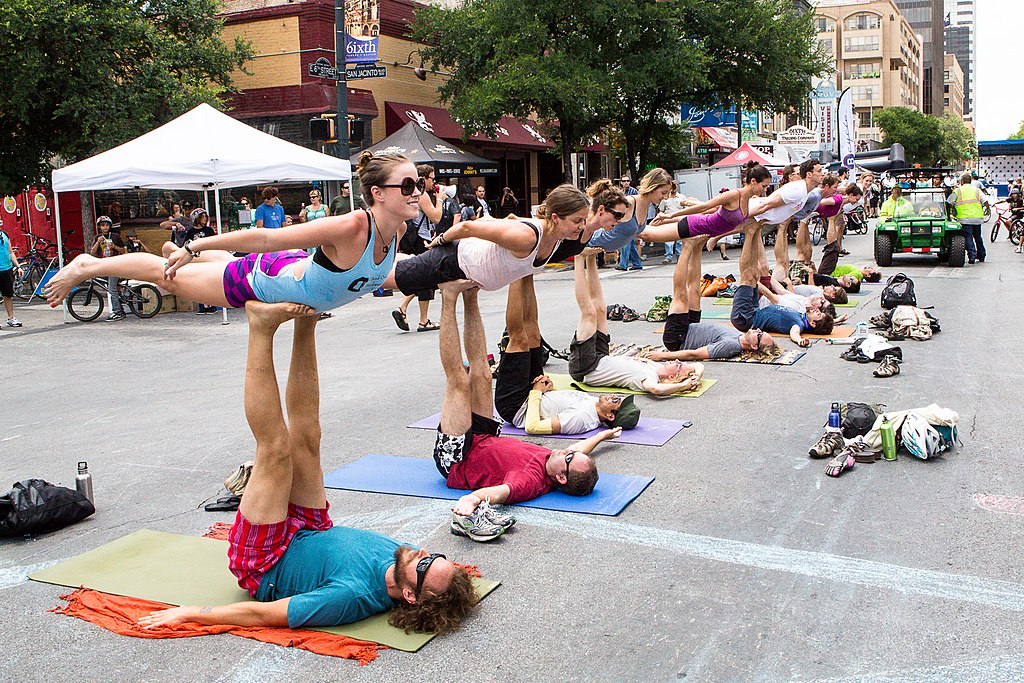JK writes: “I recently heard about a woman who suffered a horrendous injury from a type of yoga called acroyoga. Is this real yoga or another one of those spin-offs we hear about.”
Acroyoga, which is a combination of acrobatics and yoga, is a spin-off of yoga, and is real yoga – at least according to some practitioners.
In the case mentioned by JK, a 32-year-old woman from San Diego named Abby Weis suffered an accident two months ago while doing an ambitious acroyoga pose that left her paralyzed from the neck down. Described by family and friends as a fitness fanatic and enthusiastic participant in acroyoga, she is now unable to live on her own and must rely on others for even her most basic needs. This very active woman, who enjoyed dancing, hiking and traveling, told her father that since the accident, she feels like she’s in a straightjacket. Even though she had been practicing acroyoga for four years and was in excellent shape, accidents can still happen in this very rigorous form of exercise.
As this site explains, acroyoga is “built around the philosophy of forming a connection between the body and the soul and inducing mental and physical relaxation.” It differs from traditional yoga in that it requires more than one person to perform. The various roles of the partners are described as; the flyer, who is the person who performs the various poses while being held aloft by the base, who is responsible for carrying the flyer with the support of their hands and feet, most often in the L-base position which means lying on the back with the legs in the air in the form of an L. A third person, called a spotter, makes sure the flyer doesn’t fall and maintains balance with the base.
Acroyoga is not a new phenomenon. As this site explains, the roots of acroyoga can be found as far back as 1935 with yoga teacher T. Krishnamacharya who was photographed in the base position while holding aloft a child who was performing backbends. In 1985, a man named Benjamin Marantz founded AcroSage which is described as a style of therapeutic transitions and inverted flying postures that utilizes both massage and L-basing techniques. The 80’s also saw the emergence of Contact Yoga, founded by Ken Nateshvar Scott, who developed a style of yoga that involved more than one person. In 1999, Acroyoga Montreal was founded by Eugene Poku and Jessie Goldberg and blends yoga, dance, and acrobatics with restorative and yin yoga. In 2003, Acro Yoga International was born. Founded by Jason Nemer and Jenny Sauer-Klein, the pair codified the acroyoga practice and developed a discipline that eventually spread around the world.
Even though all of the sites I visited were hosted by proponents of yoga, some sites claim that the poses used by the practitioners only “mimic” yoga poses. Other sites insist that it’s all based in authentic yoga.
For example, Acroyoga Montreal claims that “there is no separation of acroyoga, yoga, and reality.”
When asked if practicing acroyoga would contradict a person’s religious affiliation, this site acknowledged that “Some poses come from the standard Yoga poses which may carry a religious undertone.”
Yoga injuries are far from uncommon. As this blog explains, even traditional yoga has caused many serious injuries in practitioners.
We do not recommend the practice of any form of yoga.
© All Rights Reserved, Living His Life Abundantly®/Women of Grace® http://www.womenofgrace.com
Send your New Age questions to newage@womenofgrace.com










